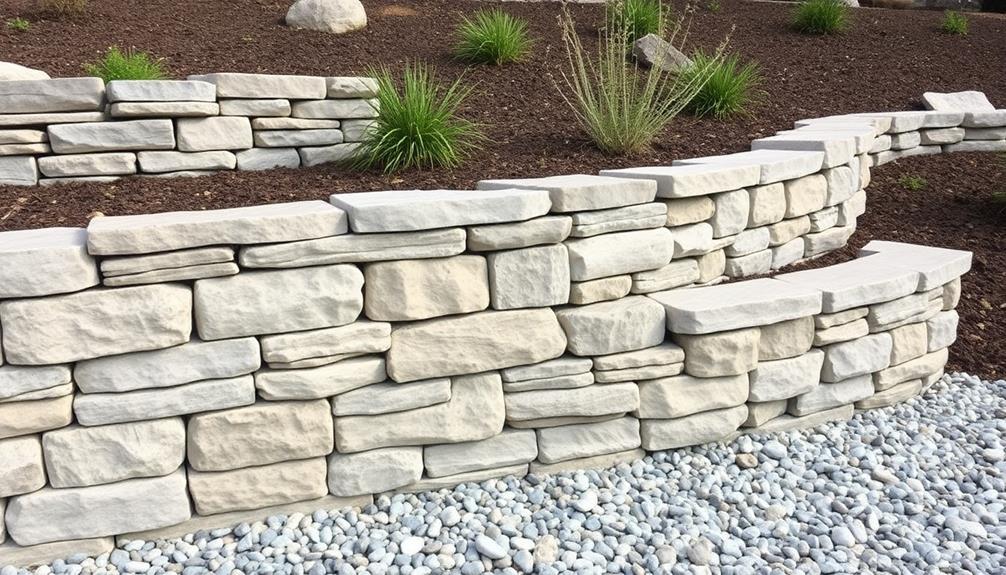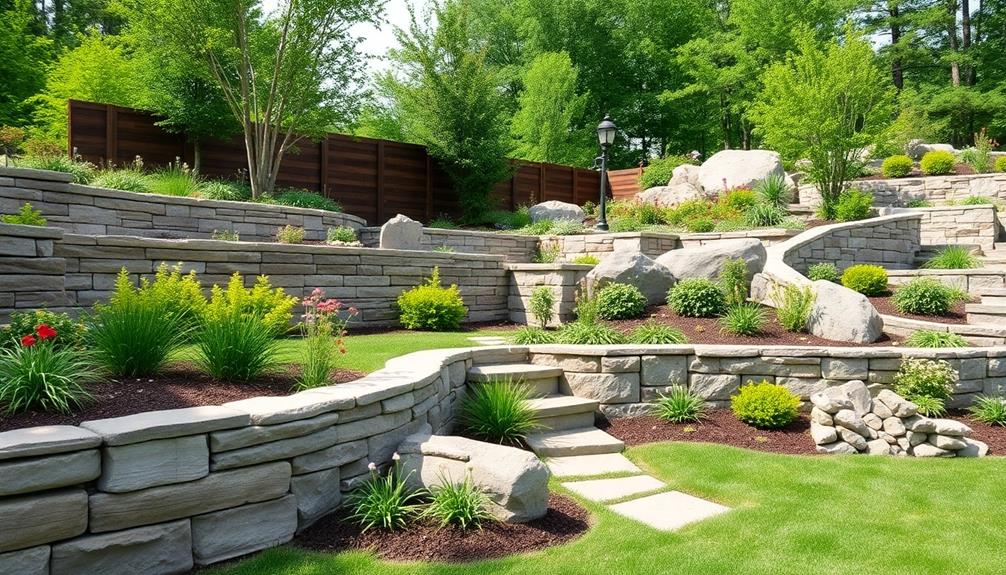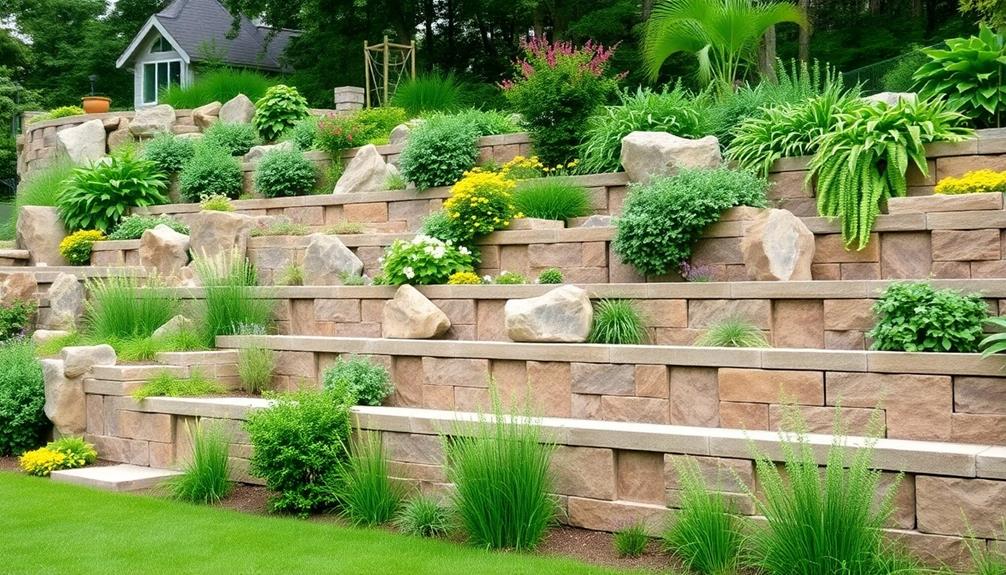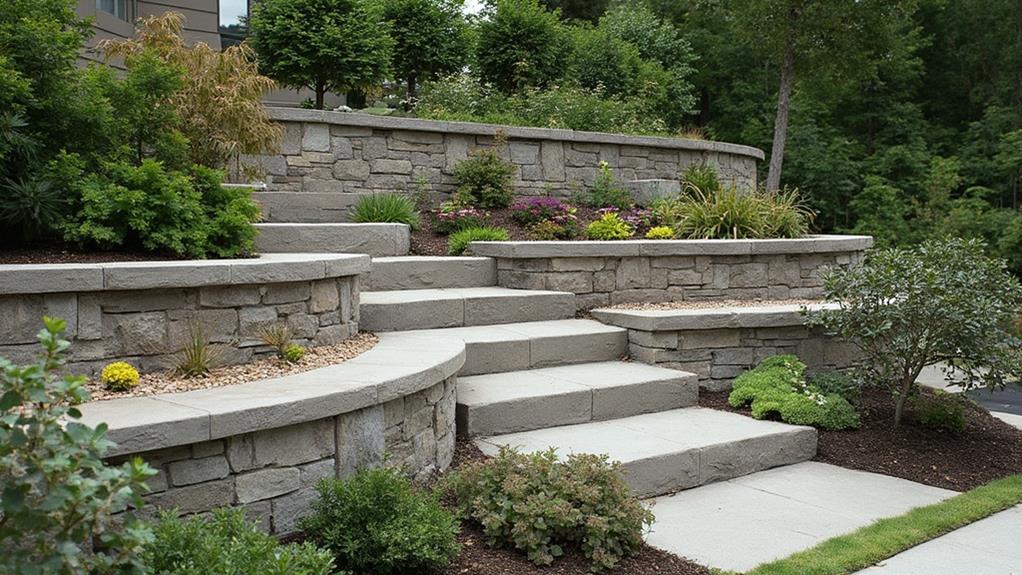Retaining walls serve both functional and aesthetic roles in landscaping, with an array of materials tailored to specific requirements. Concrete walls, known for their durability and customization, offer resistance to weather and erosion. Stone walls bring a timeless appeal, blending seamlessly with landscapes while ensuring structural integrity. Brick options provide charm and versatility for multiple uses. Timber, though less long-lasting, is favored for its rustic, natural look. Gabion and composite walls introduce modern aesthetics and eco-friendly benefits. Interlocking blocks and segmental walls stand out for ease of installation. Ultimately, reinforced concrete and masonry demonstrate unparalleled structural robustness, warranting further exploration.
Table of Contents
ToggleWalls Contractor Highlights
- Concrete walls are durable, customizable, and cost-effective, suitable for various terrains.
- Stone walls offer a timeless appearance and durability, blending well with landscapes.
- Brick walls provide classic aesthetic appeal, durability, and effective soil retention.
- Timber walls present a rustic look, are cost-effective but require regular maintenance.
- Gabion walls are durable, environmentally friendly, and effective for erosion control.
What Defines Retaining Walls?

Retaining walls are integral components in landscape architecture and civil engineering, designed primarily to restrain soil and prevent erosion while supporting vertical or near-vertical grade changes. In the Twin Cities area, retaining walls are especially significant due to the sloping terrains that homeowners frequently encounter.
The structural integrity of these walls is guaranteed through foundational elements such as footings, drainage systems, and reinforcement materials that collectively manage loads and pressure imposed by the retained earth. Companies focus on their core values by prioritizing the construction of long-lasting and aesthetic walls.
Key design considerations involve analyzing soil types, load capacity, and the intended lifespan of the wall to assure durability and effectiveness within its environmental context.
Purpose and Functionality
At its core, the purpose of a retaining wall is to hold back or stabilize soil and other materials, thereby preventing erosion and managing changes in elevation. This indispensable function enables the transformation of potentially unstable terrains into usable areas, promoting safety and expanding the scope for human development in both residential and commercial landscapes. Retaining walls are integral in regions with significant environmental variability, where maintaining land integrity is pivotal.
Functionality extends beyond merely securing soil; these structures help guide water runoff, reducing erosion while managing drainage effectively. This essential process protects the ecosystem and preserves the aesthetic integrity of landscaped areas. Retaining walls can be seen as structural allies, harmonizing nature with human development ambitions, fostering a sense of belonging among communities inhabiting varied landscapes.
Expertly designed and installed retaining walls accommodate vegetation growth, thus augmenting their environmental compatibility. Whether they delineate a pathway or serve a foundational role in terraces, their purpose is to unite form and function, aesthetic appeal with environmental necessity. These walls provide necessary support while blending seamlessly into their surroundings, underscoring the harmonious intersection between human ingenuity and the natural world. In doing so, they stand as enduring monuments to sustainable development and ecological mindfulness.
Structural Elements Explained
Understanding the elements that define a retaining wall reveals the complexity behind these seemingly simple structures. At their core, retaining walls are engineered to resist lateral pressures exerted by soil, which may also be influenced by additional factors such as water and the earth's gravitational pull. These pressures necessitate a deep understanding of the structural elements that enable retaining walls to perform their pivotal stabilizing role.
Firstly, the base is foundational to any retaining wall, providing the necessary support to bear loads and anchor the entire system. Properly constructed bases are broad and firm, designed to prevent shifting and settlement that could compromise the wall's integrity over time.
The wall itself, crafted from robust materials like concrete, stone, or steel, is the visible component, designed to withstand the lateral earth pressures and transfer them safely to its base. The strength and durability of this element cannot be overstated, as it directly correlates with the wall's effectiveness.
Furthermore, drainage systems are critical, as they mitigate hydrostatic pressure buildup, which can undermine structural stability. Often incorporated within the wall design, these systems require careful planning and execution to facilitate adequate water flow without unbalancing the structure. Together, these elements define the essence of a retaining wall's structural integrity.
Key Design Considerations
When designing a retaining wall, it is essential to account for several critical considerations that guarantee its functionality and longevity. A well-constructed retaining wall must effectively handle soil pressure while harmonizing with its surroundings and maintaining structural integrity over time.
Soil mechanics play a pivotal role, as understanding the soil type, drainage, and potential for erosion informs the choice of materials and engineering solutions. Moreover, anchorage and reinforcement are critical in preventing wall failure, particularly in complex terrains.
To craft a retaining wall that stands the test of time and environment, consider the following design elements:
- Load-Bearing Capacity: The ability of a wall to withstand earth pressure and additional loads without collapsing.
- Drainage System: Efficient drainage must be implemented to avert hydrostatic pressure buildup, which can compromise the wall's stability.
- Aesthetic Integration: Ensuring the wall complements the landscape enhances the site's visual appeal and fosters a sense of belonging for property occupants.
Incorporating these design considerations ensures the creation of a retaining wall that is not only durable and dependable but also intricately tied to its environment. This holistic approach guarantees that the retaining wall serves its functional purpose while reinforcing a connection to the natural landscape.
Benefits

The benefits of retaining wall materials extend beyond their primary functional purpose, encompassing factors such as durability and longevity, which guarantee a lasting investment in infrastructure. With the inclusion of boulder retaining walls, homeowners can enjoy increased curbside charm and creative architectural designs. In addition, these materials offer diverse aesthetic appeal options that cater to various landscape designs while remaining cost-effective, providing solutions that balance quality with budgetary constraints.
Additionally, environmental impact considerations guide the selection of sustainable materials that minimize ecological footprints, aligning structural integrity with environmental responsibility.
Durability and Longevity
Choosing the right material for a retaining wall is essential, as it directly impacts the structure's durability and longevity. For those who take pride in their landscapes and wish to safeguard their outdoor spaces, selecting robust materials ensures that the integrity of the wall stands the test of time. Durability in this context refers to the wall's ability to resist wear, pressure, and damage, while longevity speaks to its lasting performance across years, unaffected by harsh weather conditions and the ravages of time. These aspects are critical to creating a shared sense of reliability and security within a community that treasures quality in shared spaces.
The key considerations for selecting a material that fosters durability and longevity include:
- Material Type: Different materials offer varying levels of resistance to environmental stressors; for instance, natural stone is renowned for its resilience, whereas timber may require more maintenance.
- Installation Quality: Expert construction practices are paramount to ensuring the wall's stability and extending its lifespan.
- Maintenance Needs: Regular care tailored to the specific material can prevent premature deterioration, ensuring the wall remains a steadfast component of the landscape.
Focusing on these elements helps in building a retaining wall that genuinely stands the test of time.
Aesthetic Appeal Options
Aesthetic fluidity enriches landscapes by seamlessly integrating retaining walls with their natural surroundings. This intrinsic harmony is achieved through a vast array of materials and designs that cater to diverse environmental aesthetics. The careful selection of textures, colors, and forms plays a pivotal role in creating retaining structures that not only serve their purpose—preventing soil erosion and managing water flow—but also enhance the visual appeal of the area they occupy.
Among the popular choices, natural stone offers unmatched elegance and timeless beauty, effectively complementing outdoor spaces with organic, earthy tones. Brick, with its classic charm, provides a sense of tradition and stability, ideal for adding warmth and familiarity to landscapes. The versatility of concrete allows for customization, enabling designs that imitate more expensive materials while providing consistency in both appearance and performance. Timber, though less enduring, imbues a rustic and welcoming ambiance, perfect for areas that value a natural, homely aesthetic.
Each material option brings its unique character, allowing homeowners and designers alike to cultivate spaces that resonate with personal tastes and environmental themes. The result is a visually cohesive landscape, fostering a sense of belonging and connection within its community.
Cost-Effectiveness Factors
How can one achieve an efficient balance between budget constraints and retaining wall functionality? Striking a cost-effective harmony requires careful selection of materials and an understanding of each option's long-term benefits. By aligning budget considerations with practical utility, one can construct a retaining wall that not only fulfills its intended purpose but does so economically.
This involves evaluating various materials based on initial cost, durability, and maintenance needs.
Cost-effectiveness encompasses several factors, such as:
- Material Durability: Choosing materials like concrete or natural stone, which, though slightly higher in initial cost, promise a lifespan that can span decades with minimal upkeep.
- Ease of Installation: Prefabricated segments or modular blocks might entail a higher upfront investment but considerably reduce labor costs, translating to savings over time.
- Maintenance Requirements: Opt for materials with longer replacement cycles and lower repair needs, favoring options that weather environmental challenges gracefully.
An informed choice fosters a sense of belonging within communities, as well-considered retaining walls integrate into landscapes, offering safety and stability. By weighting these cost-effectiveness factors, the retention solution becomes not just an expense, but an enduring and valued asset to the environment and society.
Environmental Impact Considerations
Beyond financial considerations, the environmental benefits of selecting appropriate materials for retaining walls play a pivotal role. In an era where sustainability is increasingly valued, eco-friendly retaining wall materials not only preserve natural resources but also promote ecological well-being. Among the options, materials such as recycled concrete and natural stone are gaining popularity for their reduced environmental footprint. By choosing these alternatives, individuals contribute to a reduction in landfill waste and harness existing materials, minimizing the need for new resource extraction.
Native vegetation can also accentuate retaining walls, integrating seamlessly into landscapes and promoting biodiversity. Utilizing greenery in tandem with structural supports stabilizes soil and provides habitats for local fauna, fostering a sense of community within ecosystems. Permeable materials, another environmentally conscious selection, play an essential role in enhancing groundwater recharge and reducing surface runoff, which can otherwise lead to soil erosion and waterway contamination.
Furthermore, incorporating locally sourced materials minimizes transportation emissions, underscoring a commitment to sustainable practices that resonate with individuals dedicated to conserving their surroundings. By selecting retaining wall materials that emphasize environmental stewardship, individuals reinforce their connection to the environment, supporting a global movement toward ecologically sound construction practices.
Types of Soil Retention Methods

Understanding the various types of soil retention methods is essential in selecting the appropriate system for a given project. These methods, which are tailored to address different engineering and environmental requirements, include gravity wall structures that rely on their mass to resist pressure, anchored wall systems that use cables or rods for additional reinforcement, and geogrid reinforcement techniques that enhance soil stability through grid-like patterns. The following table provides a concise comparison of these methods:
| Soil Retention Method | Key Feature | Typical Application |
|---|---|---|
| Gravity Wall Structures | Utilizes weight to resist lateral forces | Landscaping and gardens |
| Anchored Wall Systems | Incorporates tensioned anchors | Soil stabilization in slopes |
| Geogrid Reinforcement Techniques | Uses grid-like materials for soil support | Roadway construction |
Gravity Wall Structures
Gravity wall structures represent a foundational method for soil retention, utilizing their own weight to resist lateral earth pressures. These structures rely on their mass and geometry to provide stability against the forces exerted by the soil they hold back. Typically constructed from robust materials such as concrete or stone, gravity walls are engineered to safeguard varying environmental factors and to integrate seamlessly into natural landscapes. Their design is both functionally sound and aesthetically pleasing, providing an enduring solution for embankment stabilization.
A prominent feature of gravity wall structures is their straightforward construction, which entails minimal additional supports as the weight of the wall itself serves its purpose. This method encourages a sense of belonging within the land, harmonizing built environments with nature. In the field of soil retention, acknowledging and understanding the nuances of gravity wall systems opens avenues for better community planning and sustainable development.
Material Selection: Guarantees longevity and adaptability to local conditions.
Site Analysis: Critical for determining wall height and structural needs.
Environmental Integration: Promotes ecological harmony and enhances community aesthetics.
Anchored Wall Systems
Anchored wall systems offer a versatile approach to soil retention by integrating tensile elements known as anchors or tiebacks that extend deep into the retained soil mass. These systems are particularly advantageous when dealing with challenging terrains or scenarios where space constraints limit the use of bulkier retaining structures such as gravity walls. Anchors work efficiently in transposing the tensile forces deep into the ground, hence providing stability to the wall and securing the support of the backfill material.
An anchored wall system typically consists of steel cables or rods inserted at an angle into pre-drilled holes in the soil, then connected to the wall face. The embedded length of these anchors is pivotal, often determined through detailed geotechnical analysis to guarantee the stability and success of the structure. Post-tensioning these anchors enhances their ability to combat lateral earth pressures, making them a pragmatic solution in multi-tied retaining wall systems or where finite wall deflection is necessary.
Employed in various applications from highway projects to industrial landscapes, anchored wall systems symbolize reliable and adaptable structural engineering solutions, offering members of the civil engineering community a method of ground retention that combines robustness with flexibility in design.
Geogrid Reinforcement Techniques
Geogrid reinforcement techniques complement anchored wall systems by providing an alternative method to enhance soil stability and performance. The introduction of geogrids, a mesh-like material manufactured from polymers such as polyester or polypropylene, assists in the reinforcement of soil by conferring distinct structural advantages.
Geogrids are integrated into the soil matrix to allow for a cohesive transfer of loads, reducing erosion and improving overall soil performance in both slope and load-bearing applications. Their various functions can be summarized as follows:
- Soil Reinforcement: Geogrids interlock with soil particles, creating a composite material that enhances tensile strength and distribution of stress across the earth mass.
- Increased Durability: By resisting chemical, biological, and physical degradation, geogrids enhance the lifespan of retaining wall structures, contributing to long-term durability.
- Aesthetic Integration: Compatible with natural landscapes, geogrids enable the creation of green retaining walls, fostering an environmentally harmonious design.
Walls Contractor FAQ
What Are the Most Durable Retaining Wall Materials?
When selecting durable retaining wall materials, consider concrete blocks and natural stone. Both offer longevity and strength, ensuring structural integrity and aesthetic appeal. Their timeless durability fosters a sense of community and security for landscapes and environments.
How Do I Choose the Right Retaining Wall Material for My Landscape?
Choosing the right retaining wall material involves evaluating landscape aesthetics, structural requirements, and environmental conditions. Consider materials that blend seamlessly with existing designs, are suitable for local climate, and align with budgetary constraints for long-term satisfaction and harmony.
Are Retaining Wall Materials Eco-Friendly?
Retaining wall materials vary in their eco-friendliness based on composition, sourcing, and manufacturing processes. Choosing sustainable options, such as locally sourced stones or recycled materials, can greatly reduce environmental impact while preserving the integrity of your landscape.
How Much Do Retaining Wall Materials Typically Cost?
Retaining wall material costs vary considerably, typically ranging from $15 to $60 per square foot, depending on factors such as the material type, availability, and regional considerations. Accurate budgeting fosters communal trust and project success among stakeholders.
Can Retaining Wall Materials Affect Property Value?
Quality retaining wall materials can enhance aesthetics, increase structural integrity, and provide long-term value, thereby positively influencing property value. Carefully chosen materials resonate with community standards, fostering a sense of belonging and shared neighborhood pride.







